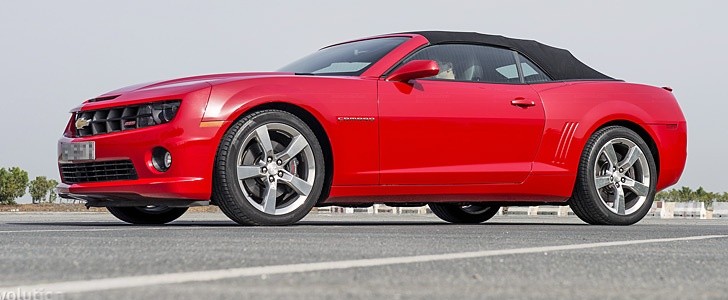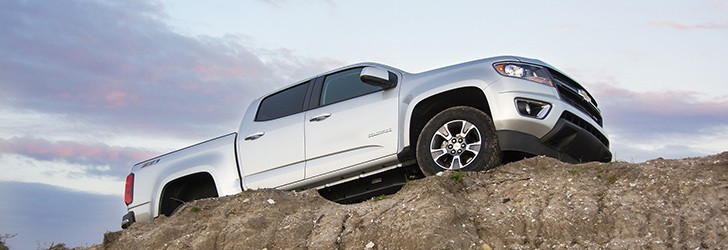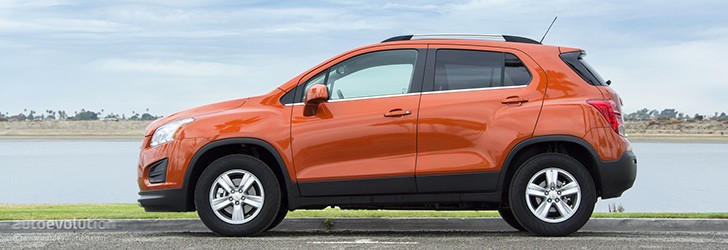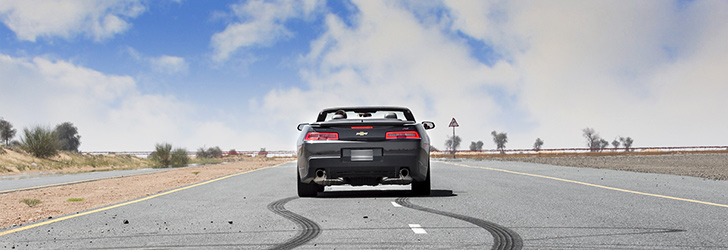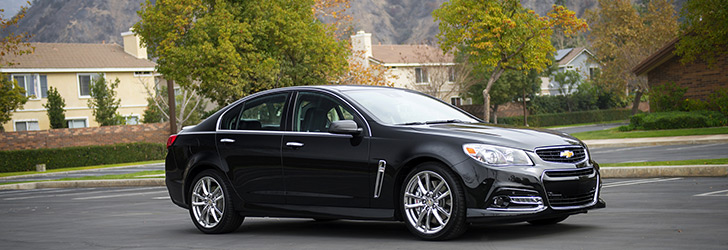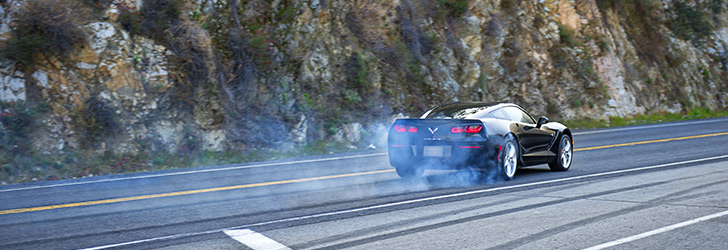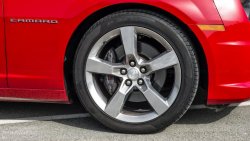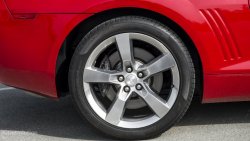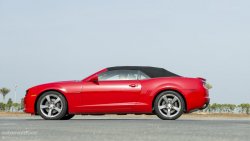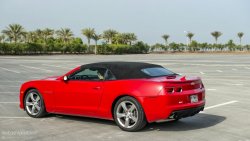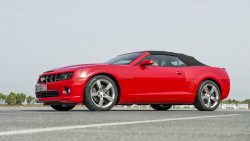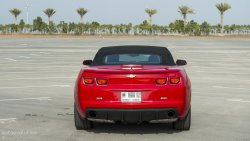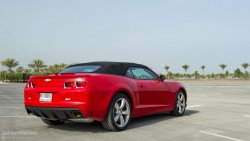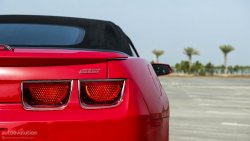CHEVROLET Camaro SS Convertible Review
OUR TEST CAR: CHEVROLET Camaro SS Convertible automatic 2012
Comfort is definitely one of the first words to use when describing the Camaro. The car has many ways of providing it, but also comes with a few elements that keep it from being perfect at this game.
The foundation is laid by the spacious cabin, which offers tons of space for those in the front and can easily accommodate children in the back. The seats are a pleasure to use and while they don't provide lateral assistance, they're a blessing during long trips.
An important element that makes you feel cozy inside the Camaro is the serious soundproofing, This does partially affect the sporty feeling of the car, but as far as this chapter is concerned, it's perfect. The dedicated layer in the canvas roof does is job extremely well and you'll never complain about any kind of noise regardless of the body type you choose.
However, driving with the top down is almost impossible without going through the hassle of manually installing the wind stopper. then There's also the problem of folding the top, as you have to manually unlatch it before using its power mechanism.
Just like the strong soundproofing, the suspension setup in the SS also seems to care a little bit more about ride than handling. No bump or pothole will disturb your inner peace, but the ride doesn't quite know how to handle small imperfections, which makes it rather unsettled.
To put it shortly, if you've got a long trip ahead of you and the keys to a Camaro, you can be certain that a pleasant experience awaits you.
The technical story of the Camaro 2SS Convertible we drove shows us the literal meaning of General Motors, as the vehicle is a joint effort coming from multiple parts of the group. As you can imagine, Chevrolet lit the revival fire, by presenting the Camaro Concept in 2007 and the Camaro Convertible Concept one year later. However, the development of the Zeta platform that underpins the Camaro was driven by GM’s Australian brand Holden.
The fact that the Camaro rides on GM’s global RWD passenger car architecture has brought both assets and drawbacks. The first category is led by the fact that this fifth-generation Camaro is the first to use independent rear suspension, while the most important of the latter is the hefty weight of the vehicle. An SS Coupe, which uses a naturally-aspirated V8, tips the scales at around 3,750 lbs (1,700 kg), while the Convertible climbs to about 4,170 lbs (1,890 kg).
Up front, the SS models uses thicker stabilizer bars compared to the V6 ones, as well as stiffer spring rates and offer less wheel travel. The Camaro uses a sub-frame that features double isolation in order to cater to both ride and handling. The rear suspension offers the same differences between V6 and V8 models as the front one. Regardless of the transmission choice, the V8 models use a limited slip differential. As a solution to minimize the rear axle hop effect, the axle halfshafts are asymmetrical in diameter.
We drove an SS with the standard wheel & tire setup, 20-inch rims with Pirelli P Zero summer performance rubber - 245/50 R19 up front and 275/40 R20 at the rear end.
When creating the Convertible, the automaker didn’t go for the usual pathway of making the suspension softer in order to cope with drawbacks brought by the open-top architecture. The suspension was left untouched, while the engineers upgraded the structure in four key points.
The A-pillars of the canvas roof model accommodate a hydroformed tube, an inner reinforcement bracket has been integrated in the windshield header, while the front hinge pillar and the rockers have also been strengthened.
As for the soft top, this uses a classical “Z” folding configuration and features a heated rear glass. It needs 20 seconds to change its state, but it does require manual operation of its latch up front. The aim was for its shape to follow the roof line of the Coupe, so it was built using composite knuckles instead of aluminum ones and taking the canvas below the belt line.
When it comes to powertrains, the Camaro SS once again shows the complex structure of General Motors. Both manual and automatic models are motivated by a naturally-aspirated 6.2-liter engine, each transmission comes with a different engine.
Both powerplants are based on the LS3 V8 that enter the market under the hood of the 2008 Corvette. The automatic-married L99 delivers 400 hp at 5,900 rpm and 410 lb-ft (556 Nm) of torque at 4,300 rpm, while the manual-mated LS3 produces 426 hp at 5,900 rpm and 420 lb-ft (569 Nm) of torque at 4,600 rpm.
The L99 is fitted with an Active Fuel Management System that shuts down four cylinders when the power requests are low. Together with the marginally lower compression ratio (10.4:1 compared to. 10.7:1), this is what makes the automatic-destined powerplant offer a slightly lower output.
The 400 hp L99 works with General Motor’s 6L80 six-speed automatic transmission, which also allows the driver to change gears using steering-wheel located paddles. The gearbox features a final drive ratio of 3.27:1.
The stopping power for the SS models is provided by Brembo hardware. At the front we have 355x32 mm rotors with four-piston calipers, while the rear receives 365x28mm discs with four-piston grabbers. In addition to that, the brake linings are semi-metallic.
For the 2013 model year, the SS models receive variable-assist electric power steering, a feature that was previously only found on the range-topping ZL1. As for the V6 models, these still have to make due with the hydraulic setup.
Chevrolet has given the Camaro range a structure that aims to cater to all sorts of needs, from those belonging to teenagers who’ll be more than happy with an entry-level V6, to the enthusiasts who will do whatever is necessary to drive the icing on this muscle car cake.
The 2013 range starts with the V6 model, which can be ordered in four configurations: 1LS and LS, as well as 1LT and 2LT.
The entry point of the range, the 1LS, offers a pretty short list of standard features, including the StabiliTrak stability control system, a six-speaker audio system and 18-inch steel wheels, albeit with a retro design. The carmaker also offers a 6-month subscription to its OnStar Directions and Connections Plan, as well as a three-month one for the SiriusXM Satellite Radio. 2LS offers the same features, but swaps the six-speed manual for an automatic transmission with the same number of gears.
To obtain a richer standard equipment level, you have to move to the LT levels, which offer a manual six-speed gearbox, but can be ordered with an automatic. The first rides on 18-inch alloy wheels, while inside we find a 7-inch touch-screen that is used by Chevrolet’s MyLink system, which will be your phone’s best friend. You also receive a small rear-view camera display integrated in the central rear-view mirror.
The 2LT brings extra standard features such as 19-inch wheels, a leather finish, Head-Up Display and a Boston Acoustics eight-speaker audio system. There’s nothing here that doesn’t make full sense, so you’ll have a hard time if you’re forced to opt for the 1LT.
Further up the range we find the SS models, which use V8 power, the 1SS and the 2SS. Along with the extra muscle, the SS models also receive tech upgrades such as Brembo brakes, a limited-slip differential, as well as 20-inch wheels wrapped in Pirelli PZero rubber.
As far as the features are concerned, the differences between the two SS trim levels are about the same as the ones for the LT models. Unlike the V6 models though, the V8 ones can be gifted with an 1LE performance package. This only targets manual models and ups the ante on the wheel&tire, suspension and transmission fronts, seriously improving the car’s feel.
We also have to mention the RS appearance package, which is offered for both V6 and V8 models and brings 20-inch wheels with a custom grey finish, HID headlights with halo rings, red badging, as well as a dedicated spoiler.
At the beginning of the chapter, we mentioned a certain kind of gearheads, who would do just about anything to drive the meanest Camaro around. We are talking about the ZL1, which punishes its rear tires with 580 hp coming from a supercharged 6.2-liter V8 and offers standard goodies such as Magnetic Ride Control. Alas, this comes at more than double the price of a V6 model.
Open the National Highway Traffic Safety Administration’s (NHTSA) history book and you’ll find that the current-generation Chevrolet Camaro has its own special place. That’s because the Camaro Coupe was the first vehicle to be awarded the best possible five-star score across the board after the NHTSA increased the difficulty level of its crash tests in 2011.
The Convertible hasn’t been assessed by any official organization, having only received a five-star rollover rating. Nevertheless, General Motors brags that the open-air model offers a stiff structure. The Camaro was conceived in a way that would allow it to also accommodate an open-top model. Of course, this doesn’t mean that chopping off the roof didn’t bring a loss of rigidity and to compensate for this, the engineers used four key strengthening measures.
The A-pillars have been reinforced, the windshield header was gifted with an inner reinforcement bracket, while the front hinge pillar, as well as the rockers have also been strengthened.
When it comes to airbags, the two models are different. Both the Coupe and the Convertible feature dual-stage front airbags for the driver and passenger, as well as seat-mounted airbags that protect the pelvis and thorax. However, the canvas roof model doesn’t have the Coupe’s roof-rail head airbags.
Moving on to the active safety features, we’ll mention the StabiliTrak electronic stability control, which keeps you on track but can also allow you to powerslide the car if that’s what you want. There are also optional features like the Head-Up Display and the rear-view camera, both of which are must-have items.
If we had to describe the Camaro in one word, we’d call it a heartbraker. It has provided joy to multiple generations of enthusiasts and it’s been the secret ingredient for countless life stories. In 2002 it was pulled off the market and it was badly missed until 2009, when a new generation was born.
Now that the Camaro is back, it does the same thing, it breaks hearts. This muscle car makes you fall in love with it using its appearance and when you get to know it better it offers you a diluted experience, leaving you craving for more. There are many who choose to ignore the problem and focus on its looks and heritage, which is why sales figures are not a problem.
The good part of the Camaro SS we drove is its exterior styling. The design is not just inspired from that of the original car, it’s also mixed with fresh elements and turns heads everywhere. The current Camaro’s styling cues have even allowed it to maintain the tradition of becoming a Transformers character, the Bumblebee autobot.
You may not expect such a bad boy to display proper Grand Tourer characteristics, but this is exactly what this car does. When you walk up to it in the parking lot, its lines will bring a smile on your face and its comfortable nature will keep this in place during any kind of long trip.
The bad part of this muscle car is its excess weight. This is an issue that GM itself has admitted and promised to correct for the next generation of the car, but until this arrives the current one has to deal with the multitude of negative consequences.
The acceleration, braking and handling are affected - You don’t buy a Camaro to be the fastest on a racetrack, but in the end, the driving emotions are less than you’d expect. From behind the wheel, the Camaro feels like it’s a bit old despite its new conception and aside from the aforementioned weight problem, a part of the responsibility for this comes from a few details of the car.
We’re referring to the engine’s shy voice, which never makes you feel that you’re controlling a 6.2-liter V8. In addition to that, the suspension allows a bit too much body roll through the corners and the setup also brings more understeer than you’d want.
For the naturally-aspirated V8 SS models, GM has found solutions for both of the aforementioned problems, but the fixes only partially solve the issues.
First of all, we had to wait for the 2013 model year to receive these fixes. It all starts with an optional dual-mode exhaust that keeps the V8 calm when you want it so, but lets it express its feelings if you step on the gas pedal.
In addition to that, there’s an optional 1LE package which sorts out the handling. Alas, this is only offered for manual-fitted SS models, so the automatic is left to wobble a bit.
As for the ugly part of the Camaro, this title goes to its interior. The cabin is not bad, but it simply lacks the shine it was expected to have after the concept car was presented. The production model keeps almost the same inspiring styling, which combines retro details with an original approach, but the materials used take away an important part of the magic.
A bit earlier we mentioned the Camaro’s sales and we have to tell you that this car doesn’t just borrow the styling from the original model, but also the affordability. You can get an entry-level V6 model for a little over $22,000 plus destination charges. If you want to be able to call it a muscle car, you’ll need a V8 under the hood, which brings the starting price to around $35,500 plus destination charges. We drove the V8-powered Convertible, which comes with a premium of around $4,000.
What’s more, the Camaro should no longer be regarded as a model that’s only destined for the US market. GM has decided to make it a global product and thus the muscle car culture can be tasted on markets such as China, Europe and South Korea. Unfortunately, the passport also brings a considerable pricing increase for the car.
The foundation is laid by the spacious cabin, which offers tons of space for those in the front and can easily accommodate children in the back. The seats are a pleasure to use and while they don't provide lateral assistance, they're a blessing during long trips.
An important element that makes you feel cozy inside the Camaro is the serious soundproofing, This does partially affect the sporty feeling of the car, but as far as this chapter is concerned, it's perfect. The dedicated layer in the canvas roof does is job extremely well and you'll never complain about any kind of noise regardless of the body type you choose.
However, driving with the top down is almost impossible without going through the hassle of manually installing the wind stopper. then There's also the problem of folding the top, as you have to manually unlatch it before using its power mechanism.
Just like the strong soundproofing, the suspension setup in the SS also seems to care a little bit more about ride than handling. No bump or pothole will disturb your inner peace, but the ride doesn't quite know how to handle small imperfections, which makes it rather unsettled.
To put it shortly, if you've got a long trip ahead of you and the keys to a Camaro, you can be certain that a pleasant experience awaits you.
The technical story of the Camaro 2SS Convertible we drove shows us the literal meaning of General Motors, as the vehicle is a joint effort coming from multiple parts of the group. As you can imagine, Chevrolet lit the revival fire, by presenting the Camaro Concept in 2007 and the Camaro Convertible Concept one year later. However, the development of the Zeta platform that underpins the Camaro was driven by GM’s Australian brand Holden.
The fact that the Camaro rides on GM’s global RWD passenger car architecture has brought both assets and drawbacks. The first category is led by the fact that this fifth-generation Camaro is the first to use independent rear suspension, while the most important of the latter is the hefty weight of the vehicle. An SS Coupe, which uses a naturally-aspirated V8, tips the scales at around 3,750 lbs (1,700 kg), while the Convertible climbs to about 4,170 lbs (1,890 kg).
Up front, the SS models uses thicker stabilizer bars compared to the V6 ones, as well as stiffer spring rates and offer less wheel travel. The Camaro uses a sub-frame that features double isolation in order to cater to both ride and handling. The rear suspension offers the same differences between V6 and V8 models as the front one. Regardless of the transmission choice, the V8 models use a limited slip differential. As a solution to minimize the rear axle hop effect, the axle halfshafts are asymmetrical in diameter.
We drove an SS with the standard wheel & tire setup, 20-inch rims with Pirelli P Zero summer performance rubber - 245/50 R19 up front and 275/40 R20 at the rear end.
When creating the Convertible, the automaker didn’t go for the usual pathway of making the suspension softer in order to cope with drawbacks brought by the open-top architecture. The suspension was left untouched, while the engineers upgraded the structure in four key points.
The A-pillars of the canvas roof model accommodate a hydroformed tube, an inner reinforcement bracket has been integrated in the windshield header, while the front hinge pillar and the rockers have also been strengthened.
As for the soft top, this uses a classical “Z” folding configuration and features a heated rear glass. It needs 20 seconds to change its state, but it does require manual operation of its latch up front. The aim was for its shape to follow the roof line of the Coupe, so it was built using composite knuckles instead of aluminum ones and taking the canvas below the belt line.
When it comes to powertrains, the Camaro SS once again shows the complex structure of General Motors. Both manual and automatic models are motivated by a naturally-aspirated 6.2-liter engine, each transmission comes with a different engine.
Both powerplants are based on the LS3 V8 that enter the market under the hood of the 2008 Corvette. The automatic-married L99 delivers 400 hp at 5,900 rpm and 410 lb-ft (556 Nm) of torque at 4,300 rpm, while the manual-mated LS3 produces 426 hp at 5,900 rpm and 420 lb-ft (569 Nm) of torque at 4,600 rpm.
The L99 is fitted with an Active Fuel Management System that shuts down four cylinders when the power requests are low. Together with the marginally lower compression ratio (10.4:1 compared to. 10.7:1), this is what makes the automatic-destined powerplant offer a slightly lower output.
The 400 hp L99 works with General Motor’s 6L80 six-speed automatic transmission, which also allows the driver to change gears using steering-wheel located paddles. The gearbox features a final drive ratio of 3.27:1.
The stopping power for the SS models is provided by Brembo hardware. At the front we have 355x32 mm rotors with four-piston calipers, while the rear receives 365x28mm discs with four-piston grabbers. In addition to that, the brake linings are semi-metallic.
For the 2013 model year, the SS models receive variable-assist electric power steering, a feature that was previously only found on the range-topping ZL1. As for the V6 models, these still have to make due with the hydraulic setup.
Chevrolet has given the Camaro range a structure that aims to cater to all sorts of needs, from those belonging to teenagers who’ll be more than happy with an entry-level V6, to the enthusiasts who will do whatever is necessary to drive the icing on this muscle car cake.
The 2013 range starts with the V6 model, which can be ordered in four configurations: 1LS and LS, as well as 1LT and 2LT.
The entry point of the range, the 1LS, offers a pretty short list of standard features, including the StabiliTrak stability control system, a six-speaker audio system and 18-inch steel wheels, albeit with a retro design. The carmaker also offers a 6-month subscription to its OnStar Directions and Connections Plan, as well as a three-month one for the SiriusXM Satellite Radio. 2LS offers the same features, but swaps the six-speed manual for an automatic transmission with the same number of gears.
To obtain a richer standard equipment level, you have to move to the LT levels, which offer a manual six-speed gearbox, but can be ordered with an automatic. The first rides on 18-inch alloy wheels, while inside we find a 7-inch touch-screen that is used by Chevrolet’s MyLink system, which will be your phone’s best friend. You also receive a small rear-view camera display integrated in the central rear-view mirror.
The 2LT brings extra standard features such as 19-inch wheels, a leather finish, Head-Up Display and a Boston Acoustics eight-speaker audio system. There’s nothing here that doesn’t make full sense, so you’ll have a hard time if you’re forced to opt for the 1LT.
Further up the range we find the SS models, which use V8 power, the 1SS and the 2SS. Along with the extra muscle, the SS models also receive tech upgrades such as Brembo brakes, a limited-slip differential, as well as 20-inch wheels wrapped in Pirelli PZero rubber.
As far as the features are concerned, the differences between the two SS trim levels are about the same as the ones for the LT models. Unlike the V6 models though, the V8 ones can be gifted with an 1LE performance package. This only targets manual models and ups the ante on the wheel&tire, suspension and transmission fronts, seriously improving the car’s feel.
We also have to mention the RS appearance package, which is offered for both V6 and V8 models and brings 20-inch wheels with a custom grey finish, HID headlights with halo rings, red badging, as well as a dedicated spoiler.
At the beginning of the chapter, we mentioned a certain kind of gearheads, who would do just about anything to drive the meanest Camaro around. We are talking about the ZL1, which punishes its rear tires with 580 hp coming from a supercharged 6.2-liter V8 and offers standard goodies such as Magnetic Ride Control. Alas, this comes at more than double the price of a V6 model.
Open the National Highway Traffic Safety Administration’s (NHTSA) history book and you’ll find that the current-generation Chevrolet Camaro has its own special place. That’s because the Camaro Coupe was the first vehicle to be awarded the best possible five-star score across the board after the NHTSA increased the difficulty level of its crash tests in 2011.
The Convertible hasn’t been assessed by any official organization, having only received a five-star rollover rating. Nevertheless, General Motors brags that the open-air model offers a stiff structure. The Camaro was conceived in a way that would allow it to also accommodate an open-top model. Of course, this doesn’t mean that chopping off the roof didn’t bring a loss of rigidity and to compensate for this, the engineers used four key strengthening measures.
The A-pillars have been reinforced, the windshield header was gifted with an inner reinforcement bracket, while the front hinge pillar, as well as the rockers have also been strengthened.
When it comes to airbags, the two models are different. Both the Coupe and the Convertible feature dual-stage front airbags for the driver and passenger, as well as seat-mounted airbags that protect the pelvis and thorax. However, the canvas roof model doesn’t have the Coupe’s roof-rail head airbags.
Moving on to the active safety features, we’ll mention the StabiliTrak electronic stability control, which keeps you on track but can also allow you to powerslide the car if that’s what you want. There are also optional features like the Head-Up Display and the rear-view camera, both of which are must-have items.
If we had to describe the Camaro in one word, we’d call it a heartbraker. It has provided joy to multiple generations of enthusiasts and it’s been the secret ingredient for countless life stories. In 2002 it was pulled off the market and it was badly missed until 2009, when a new generation was born.
Now that the Camaro is back, it does the same thing, it breaks hearts. This muscle car makes you fall in love with it using its appearance and when you get to know it better it offers you a diluted experience, leaving you craving for more. There are many who choose to ignore the problem and focus on its looks and heritage, which is why sales figures are not a problem.
The good part of the Camaro SS we drove is its exterior styling. The design is not just inspired from that of the original car, it’s also mixed with fresh elements and turns heads everywhere. The current Camaro’s styling cues have even allowed it to maintain the tradition of becoming a Transformers character, the Bumblebee autobot.
You may not expect such a bad boy to display proper Grand Tourer characteristics, but this is exactly what this car does. When you walk up to it in the parking lot, its lines will bring a smile on your face and its comfortable nature will keep this in place during any kind of long trip.
The bad part of this muscle car is its excess weight. This is an issue that GM itself has admitted and promised to correct for the next generation of the car, but until this arrives the current one has to deal with the multitude of negative consequences.
The acceleration, braking and handling are affected - You don’t buy a Camaro to be the fastest on a racetrack, but in the end, the driving emotions are less than you’d expect. From behind the wheel, the Camaro feels like it’s a bit old despite its new conception and aside from the aforementioned weight problem, a part of the responsibility for this comes from a few details of the car.
We’re referring to the engine’s shy voice, which never makes you feel that you’re controlling a 6.2-liter V8. In addition to that, the suspension allows a bit too much body roll through the corners and the setup also brings more understeer than you’d want.
For the naturally-aspirated V8 SS models, GM has found solutions for both of the aforementioned problems, but the fixes only partially solve the issues.
First of all, we had to wait for the 2013 model year to receive these fixes. It all starts with an optional dual-mode exhaust that keeps the V8 calm when you want it so, but lets it express its feelings if you step on the gas pedal.
In addition to that, there’s an optional 1LE package which sorts out the handling. Alas, this is only offered for manual-fitted SS models, so the automatic is left to wobble a bit.
As for the ugly part of the Camaro, this title goes to its interior. The cabin is not bad, but it simply lacks the shine it was expected to have after the concept car was presented. The production model keeps almost the same inspiring styling, which combines retro details with an original approach, but the materials used take away an important part of the magic.
A bit earlier we mentioned the Camaro’s sales and we have to tell you that this car doesn’t just borrow the styling from the original model, but also the affordability. You can get an entry-level V6 model for a little over $22,000 plus destination charges. If you want to be able to call it a muscle car, you’ll need a V8 under the hood, which brings the starting price to around $35,500 plus destination charges. We drove the V8-powered Convertible, which comes with a premium of around $4,000.
What’s more, the Camaro should no longer be regarded as a model that’s only destined for the US market. GM has decided to make it a global product and thus the muscle car culture can be tasted on markets such as China, Europe and South Korea. Unfortunately, the passport also brings a considerable pricing increase for the car.
THE END
12
Our CHEVROLET Testdrives:
Photo gallery (84)
